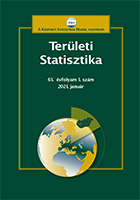A közfoglalkoztatottak munkaerőpiacra való kilépését segítő képzések Borsod-Abaúj-Zemplén megyében, 2016–2020
Training to help public workers enter the labour market
in Borsod-Abaúj-Zemplén County, 2016–2020
Author(s): Dávid Hajdú, Gábor Koncz, Katalin LiptákSubject(s): Social Sciences, Economy, Geography, Regional studies
Published by: Központi Statisztikai Hivatal
Keywords: public work; adult training; employment; unemployment; willingness to work
Summary/Abstract: The study presents the process of catching up of persons excluded from the primary labour market who participated in the subsidised adult education of public workers in Borsod-Abaúj-Zemplén County between 2016 and 2020, and analyses the success of the training courses based on job placement indicators. The training of public workers enables participants to complete the basic education they have previously abandoned, and accelerates and improves their employability through labour market training and new vocational qualifications. In line with the uneven distribution of public workers across the county,the number of trainees also varies significantly from one area to another, but this is also strongly influenced by the concentration of training in district centres and the different labour market supply.The authors used data provided by the Ministry of Innovation and Technology on the number and distribution of training courses for public workers over the period under review, and conducted a primary survey between September 2019 and June 2021, using a questionnaire to explore the life circumstances, motivations and success rates of 1,285 trainees. However, successful completion of the courses did not necessarily have the expected labour market impact, as a higher proportion of public workers returned to the secondary labour market or became jobseekers after gaining the new qualification. Thus, they have not managed to break out of the triangle defined by the status of 'job-seeker-public worker-student in subsidised adult education'. This shows that they need a significant and complex effort to find a job in the primary labour market, and in many cases, attending training has become more important to them than using it to move on.The main objective of the research is to describe the main characteristics, motivations and internal and external barriers to employment of participants in public work training. In their research, the authors considered the geographical location and the hierarchy of municipalities within the county as a crucial aspect to identify inequalities. From secondary databases, they extracted the main characteristics of the training population and the spatial differences in job placement in the primary and secondary labour markets. Their primary survey, based on questionnaires, also allowed a detailed description of the characteristics of those taking part in training and of the barriers to finding a job.
Journal: Területi Statisztika
- Issue Year: 62/2022
- Issue No: 05
- Page Range: 510-537
- Page Count: 28
- Language: Hungarian

